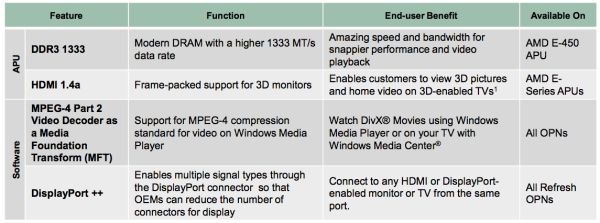AMD Updates Brazos with E-450, E-300 and C-60 APUs
by Anand Lal Shimpi on August 22, 2011 12:01 AM ESTWhen AMD first introduced its Brazos platform at the end of last year it promised annual updates to the platform. Today we get the first official update to the platform. Although not a major architectural or process change, the Brazos refresh is significant nonetheless.
At the top we've got the AMD E-450, a part we previewed at Computex. The E-450 replaces the E-350 and brings with it higher clock speeds. The two CPU cores see a mild increase from 1.6GHz to 1.65GHz, while the 80-core Radeon HD 6320 GPU creeps up from 492MHz to 508MHz. Neither sounds too impressive, but the E-450 has a new trick up its sleeve: AMD Turbo Core. Similar to Llano, if there's available TDP the GPU cores in the E-450 can turbo up to 600MHz. In GPU bound games the E-450 can be up to 22% faster than the E-350.
The E-450 also adds official DDR3-1333 support (up from 1066). When combined with the faster GPU you might see significantly better gaming performance out of the E-450. Don't expect to get anywhere near Llano's performance, but AMD notes a 36% increase in 3DMark Vantage performance.
Next up is the E-300, this replaces the single-core E-240. The E-300 has two Bobcat cores, which means the refreshed E-series APUs are all dual-core parts. The CPU clock drops a bit down to 1.3GHz, as does the GPU clock (488MHz) but overall performance should go up as nearly any usage model these days will prefer two similarly clocked cores to one.
The final update in AMD's Brazos refresh is the 9W C-60. The C-60 replaces the C-50 before it. Both feature two Bobcat cores, but the C-60 adds AMD Turbo Core support - this time on the CPU and GPU. The C-60 runs at the same 1GHz clock speed as the C-50, but it can turbo up to 1.33GHz. The GPU on the other hand can turbo up to 400MHz from its 276MHz stock speed.
The refreshed Brazos parts are still built on the same TSMC 40nm process and retain the same 18W/9W TDPs. The update to enable Turbo Core is likely only a mild change to the chip and associated BIOS. The higher clock speeds and across-the-board dual-core (E-series) come courtesy of yield improvements. In addition to the extra performance, all refreshed Brazos APUs gain multimode DisplayPort support (DP++). The ++ simply means that you can carry HDMI and DVI signals over the DP connector, allowing OEMs to build systems with only a single DP output and provide passive dongles for single-link DVI and HDMI out.
The AMD E-450, E-300 and C-60 are available from PC OEMs starting today. No word on when we'll see availability in the channel.











25 Comments
View All Comments
ltcommanderdata - Monday, August 22, 2011 - link
I was under the impression that most Displayport ports can just be converted to DVI or HDMI using a passive dongle. Is this actually an uncommon feature? Admittedly, I don't remember seeing the DP++ logo advertised, although I've never really bothered to look for it.quiksilvr - Monday, August 22, 2011 - link
Via Single-link DVI (1920x1200, 1920x1080) that is correct. However, if you want higher resolutions, you need an active converter. This, I believe, is the biggest fault of Displayport.piroroadkill - Monday, August 22, 2011 - link
With a piss-weak CPU. Surely both should be able to boost up to a fixed total TDP level.. Come on AMD!damianrobertjones - Monday, August 22, 2011 - link
I wouldn't call it 'piss-weak'. I'd call a single core Atom weak but with a nice SSD the C50 in the Acer W500 does well.piroroadkill - Monday, August 22, 2011 - link
OK, I'm not saying it's useless. Obviously a single core Atom is hopeless:- I'm simply saying that surely turbo-core on the CPU would prove more useful - this isn't exactly a gaming platform, and I'm sure the CPU will get taxed far more often than the GPU in normal usage.yuchai - Monday, August 22, 2011 - link
I'm a E-350 user and I agree with you. Who really buy these CPUs for gaming anyway? Heck, for people who do Flash games (which I'd argue people buying this is more likely to play anyway) you'd want a more power CPU.Wierdo - Monday, August 22, 2011 - link
Flash is now GPU accelerated, some tests I saw showed CPU utilization drop from 90 to 20 percent using GPUs instead of CPUs, I think this is the direction things are headed.Thunder1950 - Sunday, June 9, 2013 - link
Is that why I can't use Abode Flash Player on my Lap Top ?ET - Monday, August 22, 2011 - link
Me and many others buy these for gaming. Anyone who wants a light, inexpensive laptop that can run some games. Older games run okay, and I tried Everquest II and City of Heroes on my Thinkpad X120e, and both are reasonably playable (not great) at native resolution.A slight increase in clocks might be just what's needed to make borderline playable into playable.
oceanrock - Tuesday, August 23, 2011 - link
so i have two acer laptops one with E350 and one with i3-2310...to my surprise, the E350 system provides smoother, albeit, slower operation. it was a real surprise to me.
maybe its the intel drivers? maybe its the different power saving modes? but for a 100 dollars less and a netbook-class processor the E350 system is more enjoyable for daily operation!